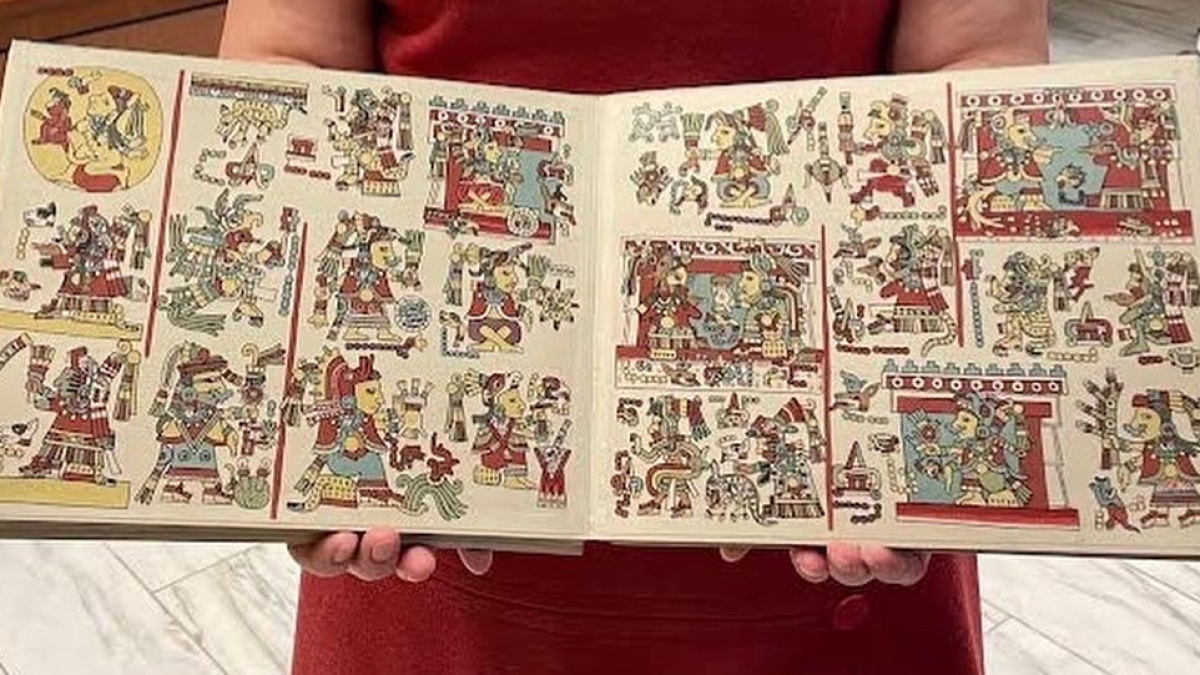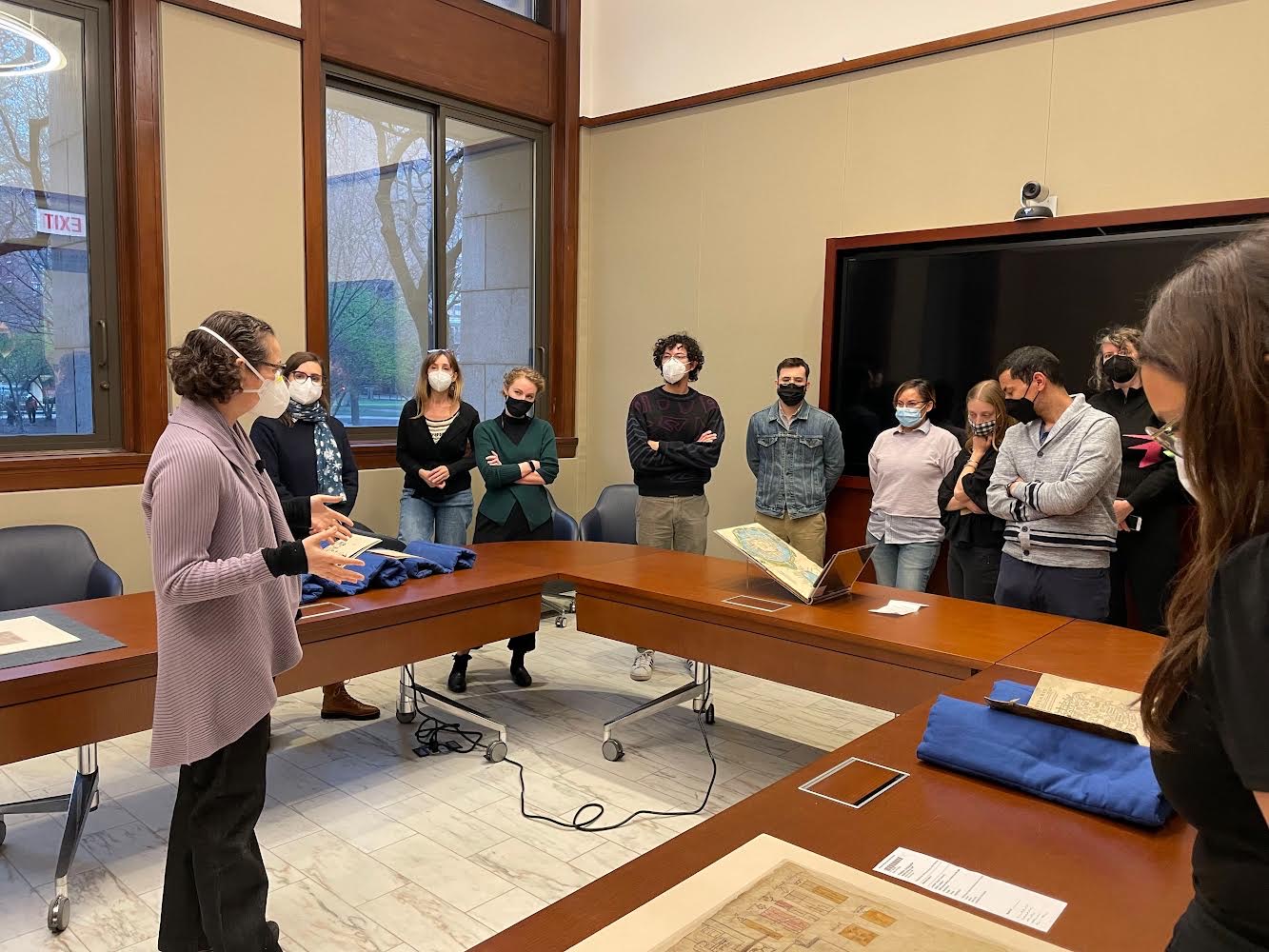Workshop offers students the opportunity to study rare documents from New Spain

Seonaid Valiant, curator for Latin American studies at the ASU Library, holds a facsimile of the Codex Nuttall, published in 1902. Photo by Lia Markey
On a cold and rainy spring Chicago day, students inside the famed Newberry Library accessed an array of rare manuscripts and materials for study and discussion.
The workshop, titled “New Spain at the Newberry Library: Demystifying Colonial Documents from the Ayer Collection,” took place April 22 and was led by Seonaid Valiant from the ASU Library and Claudia Brittenham from the University of Chicago.
The Edward E. Ayer Collection holds 4,000 rare books and manuscripts from New Spain and documents early contact between Indigenous peoples and Europeans. Aimed at helping graduate students gain skills working with primary sources, the workshop offered access to handmade documents and primary source documents, such as the Popol Vuh from Guatemala.
Partners for collaboration
The workshop was made possible by a partnership between the ASU Library and the Arizona Center for Medieval and Renaissance Studies (ACMRS), joining together with other institutions in the Newberry Consortium at the Center for Renaissance Studies. It was the first such workshop to take place in person since 2019.
The competitive workshop hosted 20 students from across the country.
"The workshop was designed to help students early in their careers understand how collections of Indigenous materials were built, how to access them and how to interpret the documents," said Valiant, curator for Latin American studies at the ASU Library.
Five applicants were from ASU, more than any other university. Czarina Lagarda López, a graduate student pursuing a PhD in Spanish and Latin American cultural and literature studies in The College of Liberal Arts and Sciences, received a scholarship to attend. In López’s undergrad and graduate studies, it was often challenging to gain access to documents in order to analyze original texts.
“What I enjoyed the most was knowing that there are plenty of resources about archives that I am interested in and that these institutions — like the Newberry Library — are open to working with us young scholars,” said López.
Examining ‘living documents’ in the archives
Claudia Brittenham, associate professor of art history at the University of Chicago, discusses a hand-painted map with workshop attendees. Photo courtesy of Seonaid Valiant
The highlight of the day was when the group examined early modern manuscripts from New Spain (1519–1821), now Mexico.
“When looking at these manuscripts, you can see how they display a continuity of Indigenous ideas stretching back to the time before the Spanish arrived in Mexico,” said Valiant. “Even in the 18th century, you can see visual elements from earlier codices that tell us about the lives of the people in the valley of Mexico.”
Students were eager to understand which symbols could be understood by both cultures, as well as the vast amount of materials that were lost. Only 14 Meso-American books are in existence today. ASU Library holds a facsimile collection of Meso-American and colonial books from Mexico available for research and study.
“One thing I learned from attending this workshop was that there are numerous possibilities to approach the archives,” said López. “Currently, we know that archives are also part of the memory and, as such, offer other epistemologies. Archives are living documents from which we can be constantly learning.”
López will carry this experience into further study and research for her dissertation.
“Something I am currently working on is the concept of race, or what would be known in the colony as castes. I am interested in seeing how Indigenous people represent themselves in these texts produced in the 16th and 17th centuries,” she said. “In this sense, it seems essential to me to analyze the texts that were made by them, such as those kept by the Newberry Library, and I hope I could find more texts about it in other libraries.”
For information about the Latin Americana Collection in the ASU Library, contact Seonaid Valiant at seonaid.valiant@asu.edu.
More Arts, humanities and education

ASU instructor’s debut novel becomes a bestseller on Amazon
Desiree Prieto Groft’s newly released novel "Girl, Unemployed" focuses on women and work — a subject close to Groft’s heart.“I…

‘It all started at ASU’: Football player, theater alum makes the big screen
For filmmaker Ben Fritz, everything is about connection, relationships and overcoming expectations. “It’s about seeing…

Lost languages mean lost cultures
By Alyssa Arns and Kristen LaRue-SandlerWhat if your language disappeared?Over the span of human existence, civilizations have…


